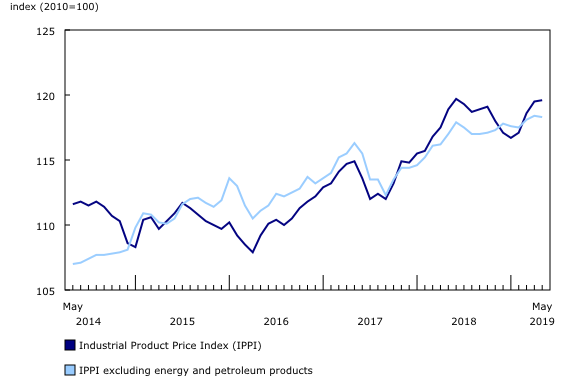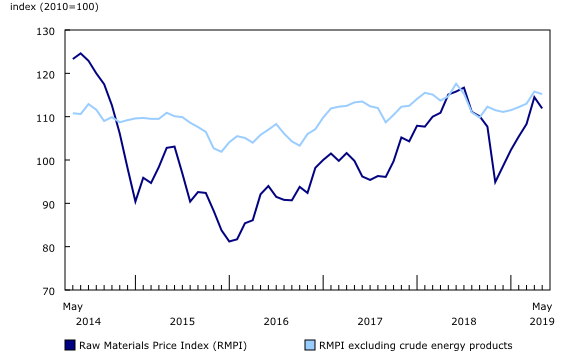Industrial product and raw materials price indexes, May 2019
Archived Content
Information identified as archived is provided for reference, research or recordkeeping purposes. It is not subject to the Government of Canada Web Standards and has not been altered or updated since it was archived. Please "contact us" to request a format other than those available.
Released: 2019-06-28
Prices for products manufactured in Canada edged up 0.1% in May. Higher prices for energy and petroleum products and for motorized and recreational vehicles were largely offset by lower prices for primary non-ferrous metal products. Prices for raw materials purchased by manufacturers operating in Canada were down 2.3%, mainly due to lower prices for crude energy products.
Industrial Product Price Index
On a monthly basis, the Industrial Product Price Index (IPPI) edged up 0.1% in May, following a 0.8% increase in April. From April to May, the Canadian dollar depreciated 0.6% relative to the US dollar. If the exchange rate had remained constant, the IPPI would have edged down 0.1%.
Of the 21 major commodity groups, 10 were up, 8 were down and 3 were unchanged.
Energy and petroleum products (+0.8%) contributed the most to the growth of the IPPI in May. This increase was mainly due to higher prices for lubricants and other petroleum refinery products (+3.5%), asphalt (except natural) and asphalt products (+3.0%), as well as motor gasoline (+0.5%). The IPPI excluding energy and petroleum products was down slightly (-0.1%).
Motorized and recreational vehicles (+0.4%) also contributed significantly to the increase in the IPPI. Higher prices for motor vehicle engines and motor vehicle parts (+0.3%), passenger cars and light trucks (+0.2%), as well as aircraft (+0.7%) were the main contributors to this increase.
Prices for meat, fish, and dairy products (+0.6%) rose for the third consecutive month in May, mainly on higher prices for fresh and frozen pork (+1.9%).The increase in the price of fresh and frozen pork was primarily due to a decrease in the global supply of hogs, caused by the presence of African swine fever in China. Prices for fresh and frozen beef and veal (+1.0%) also increased compared with April.
The growth in the IPPI was largely offset by lower prices for primary non-ferrous metal products (-1.7%). Prices for unwrought copper and copper alloys declined by 5.9%. A contributing factor was speculation about the negative impact on global demand for copper of the escalating trade dispute between the United States and China. Prices were also down for unwrought precious metals and precious metal alloys (-1.3%).
Year over year, the IPPI rose 0.6%, primarily on higher prices for motorized and recreational vehicles (+3.2%) and for meat, fish, and dairy products (+5.8%). This growth was moderated primarily by lower prices for primary non-ferrous metal products (-6.8%) and energy and petroleum products (-2.5%).
Raw Materials Price Index
On a monthly basis, the Raw Materials Price Index (RMPI) was down 2.3% in May, after five straight monthly increases. Of the six major commodity groups, four were down and two were up.
The decline in the RMPI was mainly due to lower prices for crude energy products, which decreased 4.2% in May, following a 9.5% increase the previous month. The downturn in this commodity group was mainly due to lower prices for conventional crude oil (-4.1%). The RMPI excluding crude energy products decreased 0.5%.
Prices for metal ores, concentrates and scrap (-2.1%) also exerted downward pressure on the RMPI in May, after edging up 0.1% in April.
Compared with May 2018, the RMPI was down 2.8%, following an increase of 3.2% in April. This decline was mainly attributable to lower prices for crude energy products (-6.3%).
Note to readers
The Industrial Product Price Index (IPPI) and Raw Materials Price Index (RMPI) are available at the Canada level only. Selected commodity groups within the IPPI are also available by region.
With each release, data for the previous six months may have been revised. The indexes are not seasonally adjusted.
The Industrial Product Price Index reflects the prices that producers in Canada receive as the goods leave the plant gate. It does not reflect what the consumer pays. Unlike the Consumer Price Index, the IPPI excludes indirect taxes and all the costs that occur between the time a good leaves the plant and the time the final user takes possession of it, including transportation, wholesale and retail costs.
Canadian producers export many goods. They often indicate their prices in foreign currencies, especially in US dollars, which are then converted into Canadian dollars. In particular, this is the case for motor vehicles, pulp, paper and wood products. Therefore, a rise or fall in the value of the Canadian dollar against its US counterpart affects the IPPI. However, the conversion into Canadian dollars only reflects how respondents provide their prices. This is not a measure that takes the full effect of exchange rates into account.
The conversion of prices received in US dollars is based on the average monthly exchange rate established by the Bank of Canada and available in table 33-10-0163-01 (series v111666275). Monthly and annual variations in the exchange rate, as described in the release, are calculated according to the indirect quotation of the exchange rate (for example, CAN$1 = US$X).
The Raw Materials Price Index reflects the prices paid by Canadian manufacturers for key raw materials. Many of those prices are set on the world market. However, as few prices are denominated in foreign currencies, their conversion into Canadian dollars has only a minor effect on the calculation of the RMPI.
Products
A video entitled "Producer Price Indexes" is available on the Statistics Canada Training Institute webpage. It provides an introduction to Statistics Canada's Producer Price Indexes—what they are, how they are made and what they are used for.
A Historical Timeline of Canadian Producer Price Statistics
The publication "A Historical Timeline of Canadian Producer Price Statistics," which is part of the Prices Analytical Series (62F0014M), was created to showcase the key milestones in the history of Canadian producer price statistics. This historical timeline contains answers to questions such as: Who collected Canada's first statistics? What do Canadian producer price indexes measure?
Infographic: Producer Price Indexes at a Glance
The infographic "Producer Price Indexes at a Glance," which is part of Statistics Canada — Infographics (11-627-M), demonstrates how producer price indexes for goods and services are calculated and why they are important for the Canadian economy.
Real-time table
Real-time table 18-10-0248-01 will be updated on July 12.
Next release
The industrial product and raw materials price indexes for June will be released on July 31.
Contact information
For more information, or to enquire about the concepts, methods or data quality of this release, contact us (toll-free 1-800-263-1136; 514-283-8300; STATCAN.infostats-infostats.STATCAN@canada.ca) or Media Relations (613-951-4636; STATCAN.mediahotline-ligneinfomedias.STATCAN@canada.ca).
- Date modified:





